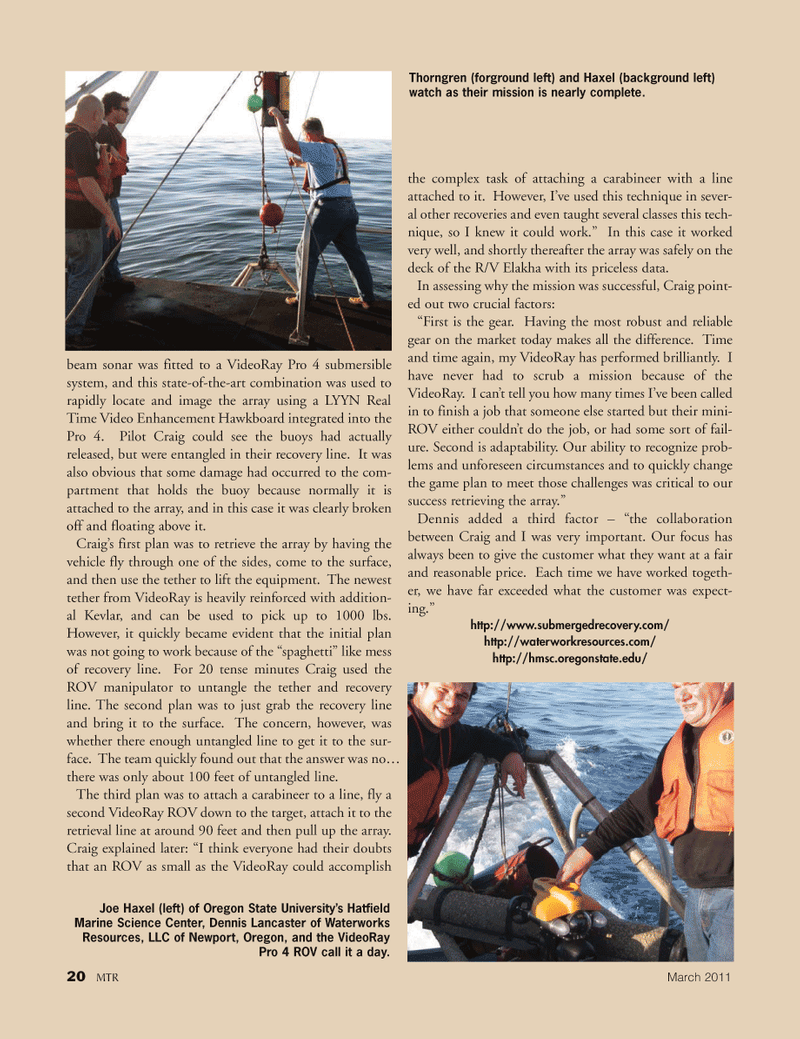
Page 20: of Marine Technology Magazine (March 2011)
Subsea Vehicles: AUV, ROV, UUV Annual
Read this page in Pdf, Flash or Html5 edition of March 2011 Marine Technology Magazine
beam sonar was fitted to a VideoRay Pro 4 submersible system, and this state-of-the-art combination was used to rapidly locate and image the array using a LYYN Real
Time Video Enhancement Hawkboard integrated into the
Pro 4. Pilot Craig could see the buoys had actually released, but were entangled in their recovery line. It was also obvious that some damage had occurred to the com- partment that holds the buoy because normally it is attached to the array, and in this case it was clearly broken off and floating above it.
Craig’s first plan was to retrieve the array by having the vehicle fly through one of the sides, come to the surface, and then use the tether to lift the equipment. The newest tether from VideoRay is heavily reinforced with addition- al Kevlar, and can be used to pick up to 1000 lbs.
However, it quickly became evident that the initial plan was not going to work because of the “spaghetti” like mess of recovery line. For 20 tense minutes Craig used the
ROV manipulator to untangle the tether and recovery line. The second plan was to just grab the recovery line and bring it to the surface. The concern, however, was whether there enough untangled line to get it to the sur- face. The team quickly found out that the answer was no… there was only about 100 feet of untangled line.
The third plan was to attach a carabineer to a line, fly a second VideoRay ROV down to the target, attach it to the retrieval line at around 90 feet and then pull up the array.
Craig explained later: “I think everyone had their doubts that an ROV as small as the VideoRay could accomplish the complex task of attaching a carabineer with a line attached to it. However, I’ve used this technique in sever- al other recoveries and even taught several classes this tech- nique, so I knew it could work.” In this case it worked very well, and shortly thereafter the array was safely on the deck of the R/V Elakha with its priceless data.
In assessing why the mission was successful, Craig point- ed out two crucial factors: “First is the gear. Having the most robust and reliable gear on the market today makes all the difference. Time and time again, my VideoRay has performed brilliantly. I have never had to scrub a mission because of the
VideoRay. I can’t tell you how many times I’ve been called in to finish a job that someone else started but their mini-
ROV either couldn’t do the job, or had some sort of fail- ure. Second is adaptability. Our ability to recognize prob- lems and unforeseen circumstances and to quickly change the game plan to meet those challenges was critical to our success retrieving the array.”
Dennis added a third factor – “the collaboration between Craig and I was very important. Our focus has always been to give the customer what they want at a fair and reasonable price. Each time we have worked togeth- er, we have far exceeded what the customer was expect- ing.” http://www.submergedrecovery.com/ http://waterworkresources.com/ http://hmsc.oregonstate.edu/ 20 MTR March 2011
Thorngren (forground left) and Haxel (background left) watch as their mission is nearly complete.
Joe Haxel (left) of Oregon State University’s Hatfield
Marine Science Center, Dennis Lancaster of Waterworks
Resources, LLC of Newport, Oregon, and the VideoRay
Pro 4 ROV call it a day.

 19
19

 21
21
